Kingdom of Oiseau
Royaume de l'Oiseau
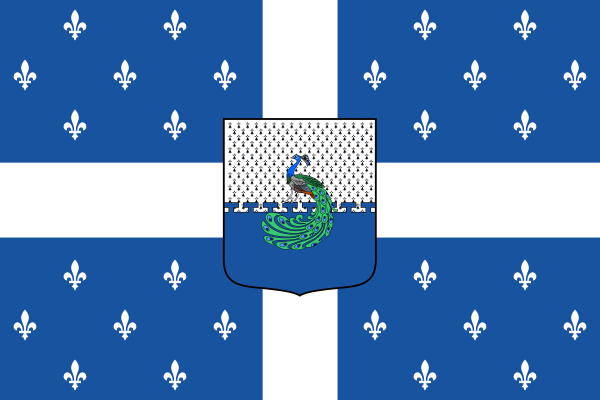 Royal Standard
Royal Standard
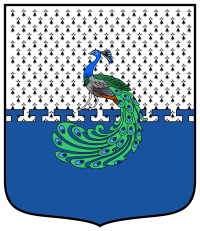 Coat of Arms
Coat of Arms
Motto: Montjoie Reine!
National Anthem: Marche Jeanne III («March of Jeanne III»)
Royal Anthem: Reine, salvam fac reginam («Reine, Save the Queen»)
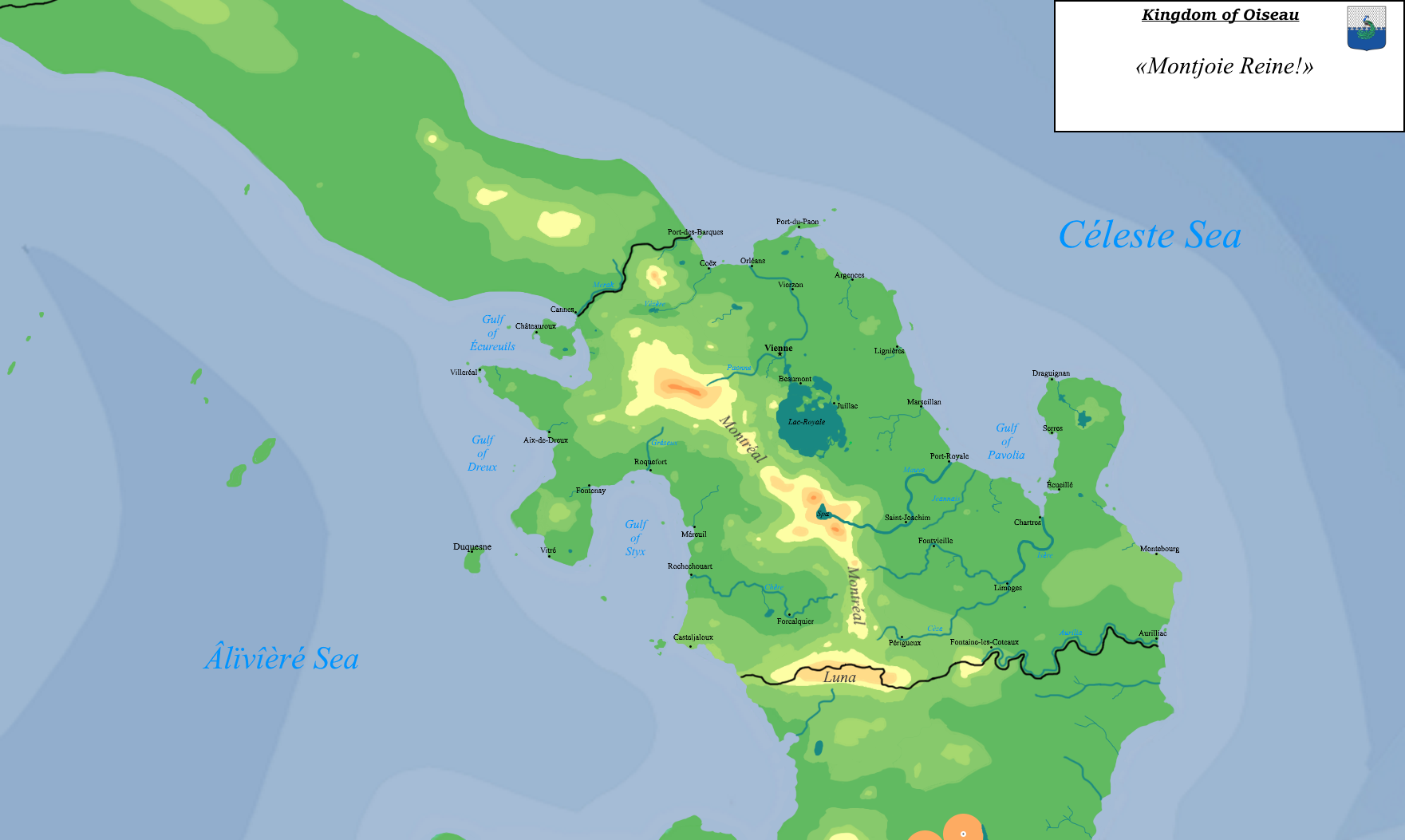
Capital: Vienne
Common Languages: Oiseaux, Daugeux, Lemovicard, Lunarisian, Pavolais, Dindes, Tupaon
Cultures:
- Oiseaux: Grandes Oiseaux, Petits Oiseaux, Roubaignot, Artagitan
- Daugeious: Daugeious, Dindes, Vaudan
- Midinie: Septimànitan, Pieds-Bruns, Lemovicard, Pavolais
- Lunarisian: Moonman, Zetan, Lusitanian
- Tupai: Tupaons
Official Religion: Reineism
Denonym(s): Oiseaux
Government: Absolute Monarchy
Queen: Louise XVII
Prince-Consort: Duc Philippe Auguste d'Orléans
Princess Royale: Louise Scholastique
Dynastic House: Paon-Vienne
Table of Contents
Introduction
Quote
s
Government
Quote
Overview
Structure
(insert useful graph)
Overview
Conclusion
Society, Culture and Religion
Quote
Society
The Queen
The Royal Family
The Court
Nobility
Overview
Ranks
Privileges
List of notables (Pair de Oiseau)
Clergy
Overview
Role within Society and Privileges
Commoners
Overview
Types and rights
Cultural Overview
Religion
Overview
Beliefs
Practices
Structure
Holy Sites and Relics
Important Religious Figures
History
Geography
«Je n’aime pas le sable. C’est grossier, rugueux et irritant... et ça va partout!»; Tr: ( «I don’t like sand. It’s coarse and rough and irritating… and it gets everywhere!»)- Reine Charlotte VII after her visit to Daugetagne
Topography
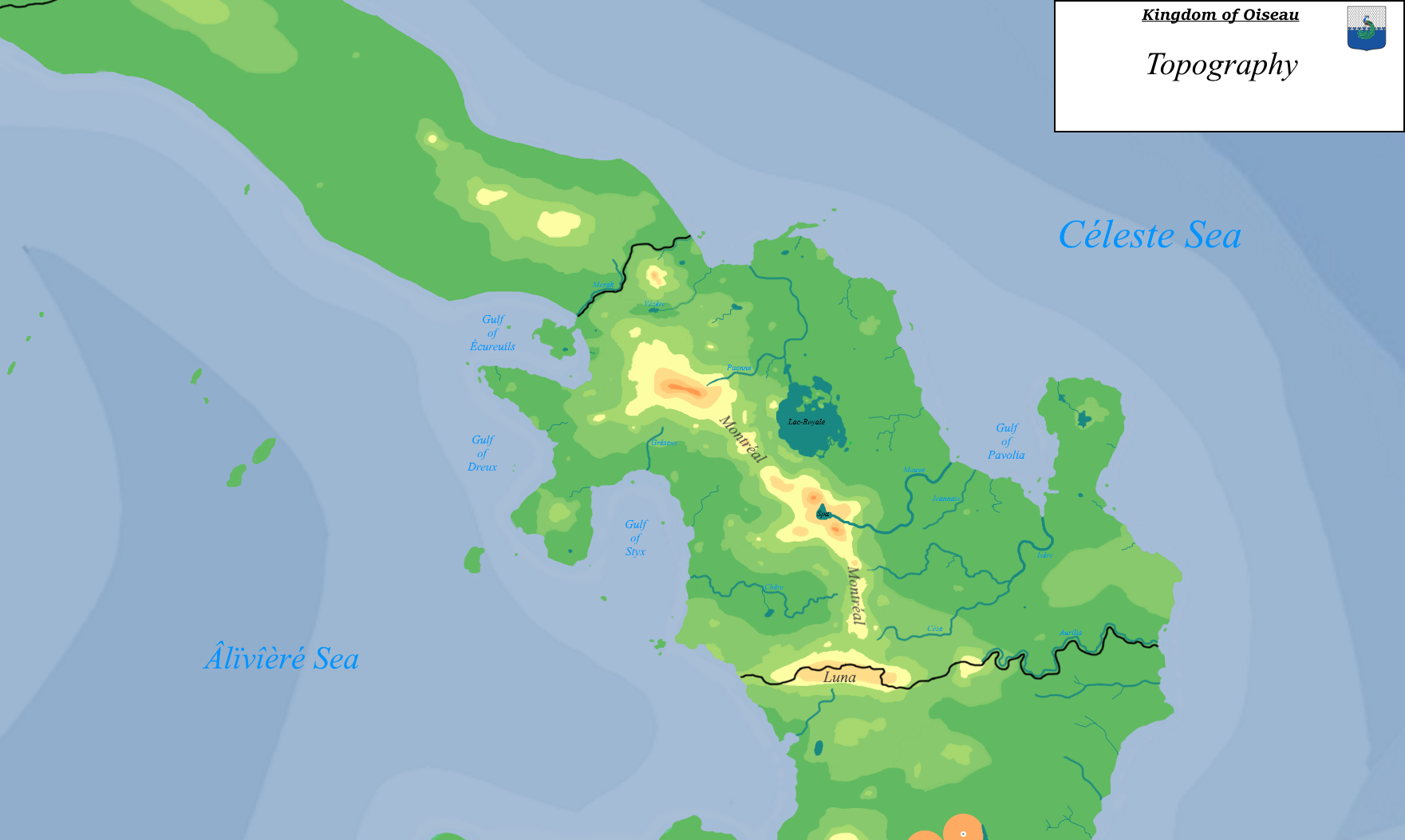
Topographically, the Kingdom is rather interesting. It is effectively divided into two parts by the Montréal Mountain Range, and this has left a major impact on the nation itself in many ways from climate to culture. The east has many flowing rivers and lakes, including the great Lac Royale which is one of the biggest fresh water lakes in the world. This abundance of water, the natural winds that flow northeast from the mountains, and the flat land of the east has led to this side of the nation being the most prosperous, and most well developed in nearly all ways. As Louise XV once said, « To lose the east, would be to lose the Kingdom itself. » Of note is that this applies mostly to the Northeast, with the Southeast, or what is known as Pavolie being not as prosperous as the northeast but when compared to the west and even neighboring nations, it is still rather prosperous in part thanks it also having many of the features of the rest of the east, being only held back by its climate.
The west on the other hand is the exact opposite and always has been since the days of when the Anyites and Ollites ruled over it. The dryness of the region and its heat have given it a negative reputation amongst the monarchs of the Kingdom itself, with Charlotte VII famously hating it. Development in the west is largely concentrated around rivers and the coast, with the northwest being something of an exemption to the rule given the climate is not as rough as in the rest of the west as a whole. This, in turn has resulted in the west being practically another nation in all matters, and its no surprise that when the Agnami Caliphate sent a force to establish itself in the west, it found great success and the Sultanate of Batikh was able to rule the lands of Géocoutagne for 150 years. Only the Montréal Mountains and the zeal of the men of Ollitaine were they contained.
The Montréal Mountains are also has interesting topographical features. Lac Spa, in the centre of the nation, famously being a caldera lake of a dormant volcano where the Mauve river starts from. Lac Spa is also a holy site within Reineism, and a notable attraction for the rich and affluent to enjoy the luxuries of the abnormally warm lake. Lac Vézère, which sits in a valley between the Montréal and Montblanc mountains is also rather unique, and famous for both its climate and biome. Many painters have found this little bit of paradise to be quite the place to depict.
Climatology and Geology

The Kingdom's climate is diverse and as unique as its topography, and once again is largely divided by the Montréal Mountains. The Mountains effectively trap moisture on the eastern side of the nation and make the west extremely hot and dry in comparison as shown by the map above. Other topographical features also cause some rather unique climates, with Lac Royale providing its surrounding area with a more wet climate but not as hot climate compared to its neighbors. Lac Vézère, as mentioned, is probably the most unique spot in the whole nation and is subject to a sub arctic continental climate that is unheard of in a subtropical nation. Another interesting feature is that the dry winds that flow from the Montréal mountains also have made a somewhat unique mixed climate of Savannah and Monsoon in the Southeast known as Tropical Lunarisian. It is a nice mix of both climate without the extremes.
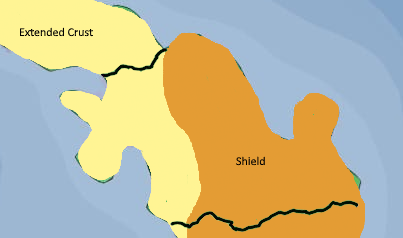
Geologically, the Kingdom lays on both extended crust and a geological shield. On The mountains are old mountains, and their height has led many to think that they used to be the tallest mountains in the world at some point. The mountains themselves are rather mineral rich, with large deposits of iron, bituminous coal, copper, bauxite, lead, nickel and zinc being found in them.
There are also rich deposits of gold, and silver that are found largely from Montblanc and around Lac Spa as well. Other minerals that are notable to the Kingdom are sulphur, quartz, asbestos, granite, graphite, limestone, and feldspar. There are several gemstone deposits as well, largely found in Spa region. These include rubies, sapphires, garnets, and aquamarine. Large clay deposits can be found in the north in particular, as well as other aggregate materials that can be found in many places across the Kingdom.
The soil quality of the Kingdom drastically depends on what side of the mountains you are on. The best soil is largely found in the Kingdom's northeastern heartland, while the worst comes in the wastes of Daugetagne and Ollitaine. This is really not much of a surprise, and most of the arid soil in the west is rocky but also good deposits of clay, sandstone and other sedimentary rocks can be found there. The Chére River is one of the few places of life in the west, originating from an aquafir and providing some degree of vegetation along its banks where agriculture can be done limitedly.
Regions
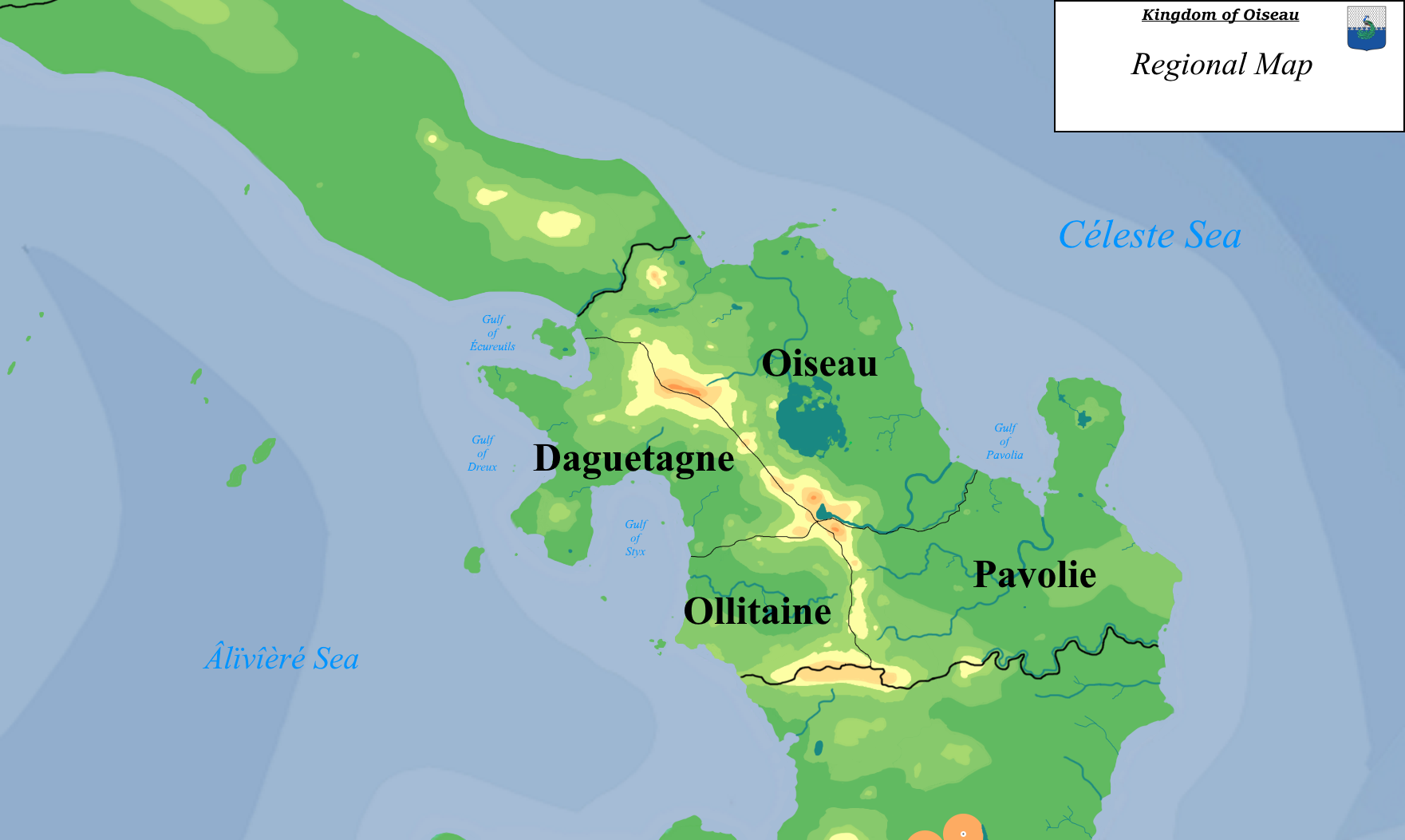
Historically and culturally, the Kingdom can be divided into four large regions known as «Stem Duchies», representing in some way both the historical and cultural aspects of the Kingdom. Three of these regions at one point were the domains of 3 different peoples, the Oiseaux, the Anyites, and the Ollites. The Anyites and Ollites ruled over Daugetagne and Ollitaine respectively. Pavolie was once known as Austrasia and was ruled by the Kingdom of Deuxlunesia it's conquest under the supervision of Marie III Magnus and Charlotte II Augusta during the period known as «La naissance d’une nation», where Marie III oversaw the annexation and integration of the former lands of the Anyites and Ollites and Charlotte II oversaw the formal breakaway of the Kingdom from the Empire and began a two century struggle that would see Pavolie as it is today annexed into Oiseau from the Kingdom of Deuxlunesia. The detailed aspects of how each of these three came into the Kingdom has played a key role into how their local cultures and socities have developed, but that discussion is to be found in the cultural overview.

Beyond the four stems, lies the twenty-eight regions that make up the Kingdom, L’île des Tempêtes included. Individual differences between each region can vary from minor to drastic depending on location, and the regions largely represent how the crown itself governs more than anything.
Economy
Quote
General Overview
The Kingdom overall has a strong and diverse economy, which can overall in productivity and GDP greatly depending on the region. It also varies greatly in many regions as should be expected.
Primary Sector
Agriculture and Fishing
The feeding of her people has always been a goal of Reine, and her divine monarchs. But Agriculture is much more than that and is one of the most crucial parts of the entire economy of the Kingdom. The Staple crop varies by region, but in general, the staple crop of the north east is Wheat, Barley, and Rhy; the Southeast, millet, soy and maize; and for the northwest, it is wheat, and barley. As for the southwest, there is no staple crop as agriculture is not that sustainable in this region at all.
The breadbasket of the nation lies as you would expect in the east, and that is where the most crops are harvest from, and also provides many diverse food sources in its wide variety of grains, cereals, fruits and vegetables. Notably, the east provides some of the more well associated crops that the Kingdom produces, chiefly being Olives, Grapes, and most importantly, Watermelons. Watermelons are a sacred crop, and as a result, the nation produces the most melons and the best melons in the entire world. The grapes grown from Oiseau vineyards vary greatly but most of them go to the Wine Industry and have made Oiseau Wine famous over the years.
Pastoral agriculture exists in all parts of the nation to some degree but is largely found in the semi-arid northwest where it is the backbone of the agricultural field in that region. All types of livestock, and poultry are raised in the northwest, with Cattle and Pigs being the most common types. The best stud farms are Artagnan, where the prized Artagnannois breed is raised.
Fishing is arguably one of the most important industries in the whole Kingdom, because it is both an essential food source for the Mid and southwest but also because it is a sacred tradition that the Goddess herself enjoys. Wars have been fought over fishing rights several times in the past, and Oiseaux fisherman are known to travel quite the distance in the ocean sometimes for exotic catches. Oceanic fishing for the most part differs from the much more sacred Lake and River fishing because of the food aspect being of greater importance and this should be noted.
Mining and Logging
Mining and Logging are key industries of national importance as well and continues to grow as the industrial needs of the nation also grow as does need for building materials. As mentioned above, most of the mineral and ore mining takes place in the mountain ranges but to add more detail to what has been said, the growth within the mining sector in recent years has been a key part in the nation's economic growth as a whole that is shown in the secondary sector. Iron and Coal in particular have a increasingly important role and with ample supply, it seems that the demand will be matched by increased production. Furthermore, the construction and aggregate industry is also grown to match the times as well, and its demand is also being met. The rebuilding and rebirth of the formerly lost cities in the west will require much of these sectors, but cities of brick and mortar are being formed on top of the ruins. While the west will never be what the east is, the attempts by the government to beautify theses new cities will go a long way cultural.
The Logging industry is also an extremely important industry, but one that is not undergoing rapid expansion to meet demand as this demand is being fulfilled by cheap Tupai lumber from the north. If anything, the logging industry is in decline somewhat nationally as some of the former loggers from the mountainous interior have indeed relocated north while their former lands are being replanted with fresh new trees. There still exists a profitable logging industry in these regions, however regulated. The needs of the nation however have outpaced the abilities locally, and the Navy is increasingly switching towards Tupai Lumber.
Secondary Sector
This sector of the economy is growing rapidly, in both the numbers of skilled and unskilled laborers. There are four key parts of the secondary sector for the Kingdom: Light Industry, Chemical Industry, Material Industry and Heavy Industry. Each of them will be briefly overviewed in the following sections.
Light Industry
Light industry are industries that usually are less capital-intensive than heavy industry and are more consumer-oriented than business-oriented, as they typically produce smaller consumer goods. For laymen, this essentially means that these industries take up less space, require less manpower, are less labour intensive and also that most of the goods produced here are end products.
For Oiseau, this largely manisfests itself in the food industry, which includes but not is limited to important Wine Making and Food processing industries that are the source of many luxuries; the growing textile industry that is benefiting from the growing capabilities of factories; Clothing, Leather, and luxury goods industries
Artisans of these light industrial goods have had to switch towards a more luxury bend in recent years with many of the simplier goods being made cheaper and faster by mass industry, despite the grumblings of some. But this transition has not truly negatively affected many artisans, who have been able to adapt with the help of the government itself and light industries can be found anywhere, with the more factory based industries found near ports.
Chemical Industry
The chemical industry is a growing one, that forms one of the intermediate industries from which other goods are produced. New processes for paper making, leather tanning, fertilizer, coking, explosives and even cosmetics are growing in importance as a whole. All of these and more seem to have a bright future within the economy.
These industries are largely to be found either close there where the raw materials that goes into them are found such as in the more mountainous areas, or within the major cities and ports.
Material Industry
Material Industry, in essence, is a one of the most important intermediate industries and is growing rapidly in importance as the demand for the processed raw materials such as lumber, metals, glass, ceramics, and cement grows. It is notable that the Metallurgy industry can also fall into Heavy Industry as well as it grows in complexity.
As with the other intermediate industry of note, chemicals, these industries are almost all concentrated around where the raw materials are found.
Heavy Industry
Heavy industry is an industry that involves one or more characteristics such as large and heavy products; large and heavy equipment and facilities (such as heavy equipment, large machine tools, huge buildings and large-scale infrastructure); or complex or numerous processes.
The truth of the heavy industrial sector is that it is currently rather limited to mostly shipbuilding and the weapons industry, with some ventures into machine tools and steel currently being undertaken.
Tertiary Sector
The service sector is a rather underrated part of a nation's economy, as from it such things as trade, entertainment, healthcare, and financial management come from.
For the Kingdom, trade and entertainment are both of great importance for both the economy as a whole and for the people of the land. As a land of artists, poets and musicians; entertainment has always flourish under the patronage of others, from merchants to the Queen herself. The construction of theatres, museums and amphitheatres have shown this importance over the years.
Trade is also extremely important, as without it, the economy as a whole would likely collapse. The Kingdom has a some what above average merchant marine and strict controls on how trade is conducted to ensure that this industry succeeds but also that locals are protected from foreigners.
Military
Quote
Armée Royale
«Avec l'élan, tous les ennemis sont vaincus!» Tr. («With Élan, all enemies are defeated.»)- Motto of Armée Royale
Overview of the Armée Royale
The Royal Army (Armée Royale) is one of the most powerful in the region, and perhaps even Ailivia itself. It has a long tradition of success and victory dating back to the Kingdom's founding and is a well-rounded force that specializes in offensive operations and attacks.
Brief History
The Royal Army itself only dates back to 909, with it's foundation thanks to the reforms of Sébastien de Dampierre, Comte de Étampes, but the roots of this army date further back than that. During the «La naissance d’une nation», the feudal army of Oiseau was able to crush the Ollites in numerous battles with their excellent Cavalry and Infantry, and also fend off Lunesian attacks. In time, the states long rivalry with Deuxlunesia resulted in the strong martial culture and the great Élan that the army would fight with as it transitions into a modern force.
Wars against the Écureuils were also numerous, with several punitive expedition venturing deep into their lands and ultimately burning the tree city of Panrong down twice in 957, and 1021. Defeats against them also gave the Kingdom a strong skill in fighting against guerillas, with the Chasseurs being a result of these wars. After the second sack of Panrong, the wars with the squirrels died down as a new threat to the south had run over much of Géocoucou, and the border was made to be at the Barques River.
The long struggle century against the Batikh was brutal and viscious. Both sides would beat each other, and at one point the Batikh cross the Montréal into Oiseau itself though they were crushed, and the borders ended up forming around the Lac Vézère-Mérieul boundary that would last for 40 years until the defeat of the Batikh in the north by the Marquis de Maumigny in 1124 and the destruction of the state itself by 1134.
Organization
Composition
Doctrine
Order of Battle
Marine Royale
«Percute velocem, et percute dura» Tr. («Strike quick, and strike hard») - Motto of Marine Royale
Overview of the Marine Royale
History
Organization
Composition
Doctrine
Order of Battle
Diplomacy
Quote